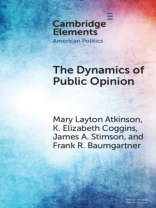A central question in political representation is whether government responds to the people. To understand that, we need to know what the government is doing, and what the people think of it. We seek to understand a key question necessary to answer those bigger questions: How does American public opinion move over time? We posit three patterns of change over time in public opinion, depending on the type of issue. Issues on which the two parties regularly disagree provide clear partisan cues to the public. For these party-cue issues we present a slight variation on the thermostatic theory from (Soroka and Wlezien (2010); Wlezien (1995)); our "implied thermostatic model." A smaller number of issues divide the public along lines unrelated to partisanship, and so partisan control of government provides no relevant clue. Finally, we note a small but important class of issues which capture response to cultural shifts.
Mary Layton Atkinson & Frank R. Baumgartner
Dynamics of Public Opinion [PDF ebook]
Dynamics of Public Opinion [PDF ebook]
Köp den här e-boken och få 1 till GRATIS!
Språk Engelska ● Formatera PDF ● ISBN 9781108872430 ● Utgivare Cambridge University Press ● Publicerad 2021 ● Nedladdningsbara 3 gånger ● Valuta EUR ● ID 8172079 ● Kopieringsskydd Adobe DRM
Kräver en DRM-kapabel e-läsare












